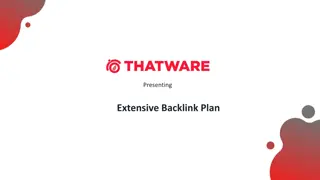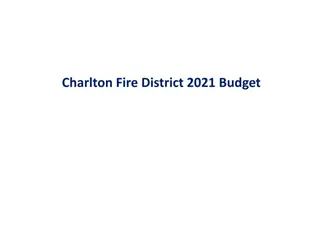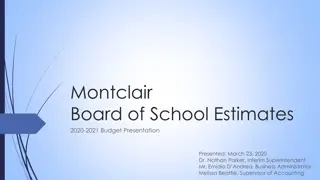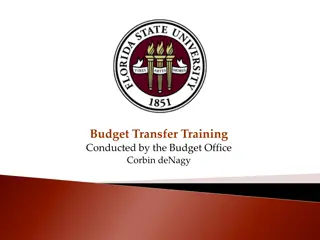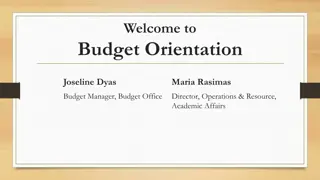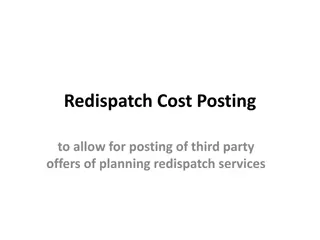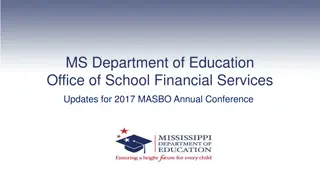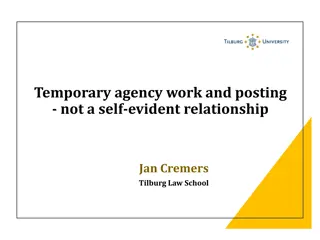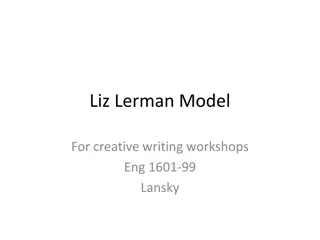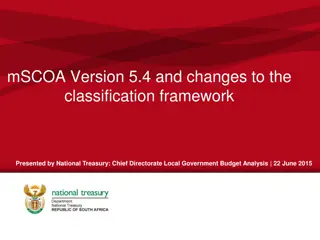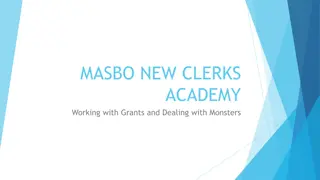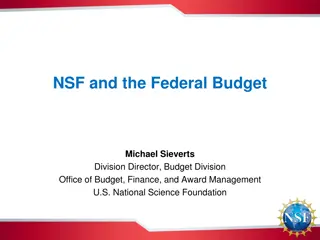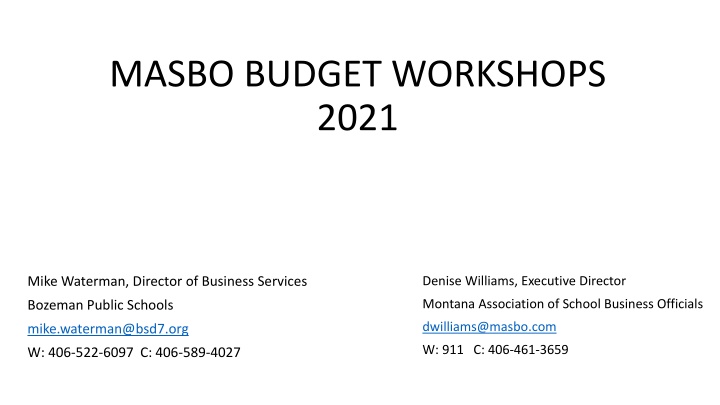
Effective Budgeting Steps for School Districts
Learn about budgeting steps for school districts including enrollment count analysis, funding sources, and serving students to obtain additional resources efficiently. Stay informed to enhance your district's financial planning.
Download Presentation

Please find below an Image/Link to download the presentation.
The content on the website is provided AS IS for your information and personal use only. It may not be sold, licensed, or shared on other websites without obtaining consent from the author. If you encounter any issues during the download, it is possible that the publisher has removed the file from their server.
You are allowed to download the files provided on this website for personal or commercial use, subject to the condition that they are used lawfully. All files are the property of their respective owners.
The content on the website is provided AS IS for your information and personal use only. It may not be sold, licensed, or shared on other websites without obtaining consent from the author.
E N D
Presentation Transcript
MASBO BUDGET WORKSHOPS 2021 Denise Williams, Executive Director Mike Waterman, Director of Business Services Montana Association of School Business Officials Bozeman Public Schools dwilliams@masbo.com mike.waterman@bsd7.org W: 911 C: 406-461-3659 W: 406-522-6097 C: 406-589-4027
Agenda 1. Budgeting Steps 2. LC2554 3. Budgeting in the Age of ESSER Grants
Budgeting Steps Conventional: 1. Complete enrollment counts 2. Wait for OPI to release preliminary budget data sheets, budget spreadsheet
Sample School District Historical Enrollment Count 900 797 791 771 800 747 700 557 556 600 540 516 Enrollment 500 400 300 240 235 231 231 200 100 0 2017 2018 2019 2020 2021 Projected Total Enrollment Elementary Enrollment High School Enrollment
Sample School District Historical Enrollment Count These students drive the funding (funding source) 900 797 791 771 800 747 700 557 556 600 540 516 Enrollment 500 400 300 240 235 231 231 200 100 0 2017 2018 2019 2020 2021 Projected Total Enrollment Elementary Enrollment High School Enrollment
that will be used to serve these students (funding use) Sample School District Historical Enrollment Count These students drive the funding (funding source) 900 797 791 771 800 747 700 557 556 600 540 516 Enrollment 500 400 300 240 235 231 231 200 100 0 2017 2018 2019 2020 2021 Projected Total Enrollment Elementary Enrollment High School Enrollment
Our job: Identify these students in order to: 1. Know what you need to serve them 2. Possibly obtain additional resources for your District Sample School District Historical Enrollment Count 900 797 791 771 800 747 700 557 556 600 540 516 Enrollment ??? 500 400 300 240 235 231 231 200 100 0 2017 2018 2019 2020 2021 Projected Total Enrollment Elementary Enrollment High School Enrollment
Budgeting Steps budget spreadsheet X Conventional: 1. Complete enrollment counts 2. Wait for OPI to release preliminary budget data sheets, Recommended: 1. Complete enrollment counts 2. Project enrollment for ensuing October 3. Determine eligibility for anticipated unusual enrollment increase 4. Calculate budget, tax impacts 5. Seek Board approval, submit projections to OPI 6. Monitor projections vs actual in ensuing October
Student Count Current Year Student Count Next Year Grade Projecting Enrollment K 1 2 30 3 ??? 4 5 The Eyeball Method: Extension Exercise 6 7 8 9 10 11 12 Total K-12
900 Sample School District Historical Enrollment Count 797 791 771 800 747 700 600 557 556 540 516 500 400 300 240 235 231 231 200 100 0 2017 2018 2019 2020 2021 Projected Total Enrollment Elementary Enrollment High School Enrollment
900 Sample School District Historical Enrollment Count 797 791 771 800 747 700 600 557 556 540 516 500 400 300 240 235 231 231 200 100 0 2017 2018 2019 2020 2021 Projected Total Enrollment Elementary Enrollment High School Enrollment
Sample School District Historical Enrollment Count Recommended order for developing enrollment projections: 1. Classes for which you have full history 2. Classes for which you have partial history 3. Project Kindergarten last Historical average Other methods 4. Classes for which you have partial history 5. Project Kindergarten last Historical average
Sample School District Historical Enrollment Count Recommended order for developing enrollment projections: 1. Classes for which you have full history 2. Classes for which you have partial history 3. Project Kindergarten last Historical average Other methods 4. Classes for which you have partial history 5. Project Kindergarten last Historical average
Sample School District Historical Enrollment Count Recommended order for developing enrollment projections: 1. Classes for which you have full history 2. Classes for which you have partial history 3. Project Kindergarten last Historical average Other methods 4. Classes for which you have partial history 5. Project Kindergarten last Historical average
Sample School District Historical Enrollment Count Recommended order for developing enrollment projections: 1. Classes for which you have full history 2. Classes for which you have partial history 3. Project Kindergarten last Historical average Other methods 4. Classes for which you have partial history 5. Project Kindergarten last Historical average
Sample School District Historical Enrollment Count Observations/takeaways: 1. Enrollment increases possible even in districts with falling enrollment 2. Keep an eye on bubble classes 3. Anticipate changes to budget limits Grades FY21 Per-ANB Entitlement K-6 (E) $5,727 7-8 (M) $7,333 9-12 (H) $7,333
Heads Up! HB329 - "Students with Special Needs Equal Opportunity Act : Resident public school district contributes General Fund amount for non- enrolled special ed student s use via OPI. Amount is lesser of: District s average General Fund budget per pupil Statewide average General Fund budget per pupil District counts students for ANB funding
Projecting Enrollment During COVID Possible sources of info County Superintendent Private Schools Call them and ask!
Your toolbox Spreadsheet on MASBO website
Projecting Enrollment Use Enrollment Projections tab to summarize your October enrollment history and develop projections for next year
Bozeman Public Schools Enrollment History and Projections
And not just YOUR enrollment Rural Elementary Feeder Schools Enrollment History 1,200 1,084 1,072 1,029 969 952 1,000 824 784 766 800 694 687 651 624 622 606 598 Students 600 400 200 0 2006 2007 2008 2009 2010 2011 2012 2013 2014 2015 2016 2017 2018 2019 2020 Monforton Anderson Gallatin Gateway LaMotte Cottonwood Malmborg Total
Yeahbut does it work? 9,000 8,000 7,000 6,000 Projection - Previous Year 5,000 Projection - 5 Years Prior 4,000 Projection - 10 Years Prior Actual 3,000 2,000 1,000 0 2009 2010 2011 2012 2013 2014 2015 2016 2017 2018 2019 2020
The * The importance of I ll believe it when I see it
Bozeman Public Schools Enrollment History and Projections 4,500 Actual Projected 4,000 3,500 3,000 2,500 Students 2,000 1,500 1,000 500 0 2011 2012 2013 2014 2015 2016 2017 2018 2019 2020 2021 2022 2023 2024 2025 2026 2027 2028 2029 2030 2,717 2,801 2,907 2,946 3,037 3,184 3,185 3,235 3,225 2,892 3,360 3,390 3,457 3,536 3,564 3,658 3,603 3,656 3,709 3,764 Middle School Enrollment (Grades 6-8) 1,215 1,251 1,316 1,375 1,472 1,440 1,535 1,536 1,626 1,574 1,695 1,694 1,673 1,675 1,703 1,704 1,869 1,874 1,948 1,861 High School Enrollment (Grades 9-12) 1,844 1,909 1,963 1,973 1,996 2,118 2,168 2,224 2,260 2,398 2,432 2,551 2,652 2,647 2,760 2,722 2,698 2,770 2,703 2,912 Elementary Enrollment (Grades K-5)
Bozeman Public Schools Enrollment vs. Building Capacity 4,500 Projected Actual 4,000 3,500 3,000 Students 2,500 2,000 1,500 1,000 500 0 2011 2,717 2,801 2,907 2,946 3,037 3,184 3,185 3,235 3,225 2,892 3,360 3,390 3,457 3,536 3,564 3,658 3,603 3,656 3,709 3,764 2,840 2,840 3,080 3,374 3,374 3,374 3,394 3,496 3,496 3,496 3,496 3,496 3,496 3,496 3,496 3,496 3,496 3,496 3,496 3,496 Middle School Enrollment (Grades 6-8) 1,215 1,251 1,316 1,375 1,472 1,440 1,535 1,536 1,626 1,574 1,695 1,694 1,673 1,675 1,703 1,704 1,869 1,874 1,948 1,861 Middle School Building Capacity 1,470 1,470 1,470 1,470 1,470 1,470 1,470 1,803 1,803 1,803 1,803 1,803 1,803 1,803 1,803 1,803 1,803 1,803 1,803 1,803 High School Enrollment (Grades 9-12) 1,844 1,909 1,963 1,973 1,996 2,118 2,168 2,224 2,260 2,398 2,432 2,551 2,652 2,647 2,760 2,722 2,698 2,770 2,703 2,912 High School Building Capacity 2,400 2,400 2,400 2,400 2,400 2,400 2,400 2,400 2,400 3,000 3,000 3,000 3,000 3,000 3,000 3,000 3,000 3,000 3,000 3,000 2012 2013 2014 2015 2016 2017 2018 2019 2020 2021 2022 2023 2024 2025 2026 2027 2028 2029 2030 Elementary Enrollment (Grades K-5) Elementary Building Capacity
Budgeting Steps Recommended: 1. Complete enrollment counts 2. Project enrollment for ensuing October 3. Determine eligibility for anticipated unusual enrollment increase 4. Calculate budget, tax impacts 5. Seek Board approval, submit projections to OPI 6. Monitor projections vs actual in ensuing October
Anticipated Enrollment Increases Calendar of Events Event Timeline Fall Enrollment Count First Monday in October Spring Enrollment Count First Monday in February Deadline for Calling for a May election February 23 (70 days before) Preliminary Budget Data Sheets released by OPI March 1 Deadline for finalizing ballot language April 2 (30 days before) 90th day of Legislative Session May 1 Deadline for submitting Application for Additional ANB to OPI June 1 Final Preliminary Budget Data Sheet available Fourth Monday in June
Anticipated Enrollment Increases Understanding ANB (Average Number Belonging) Generally: Adjusted Fall enrollment + Adjusted Spring Enrollment 2 X 187/180 rounded up to nearest integer
Anticipated Enrollment Increases Understanding ANB (Average Number Belonging) Exercise: calculate your ANB
Anticipated Enrollment Increases How does the funding work? Anticipated enrollment in Oct of budget year Remainder of enrollment increase Lesser or 4% or 40 students (not funded!) Students Prior year average enrollment (Oct enrollment + Feb enrollment) 2 State Funding Local Taxes
Anticipated Enrollment Increases Understanding ANB (Average Number Belonging) Oct 2020 Actual Enrollment Oct 2021 Grade Projected Enrollment Change Grade 9 703 621 Grade 10 595 677 Grade 11 571 573 Grade 12 529 561 High School Total 2,398 2,432 34 Is Bozeman High School eligible for an anticipated unusual enrollment increase?
Anticipated Enrollment Increases Understanding ANB (Average Number Belonging) Oct 2020 Actual Enrollment Feb 2021 Actual Enrollment 2020-21 Average Enrollment Oct 2021 Projected Enrollment Grade Change Grade 9 703 704 621 Grade 10 595 590 677 Grade 11 571 557 573 Grade 12 529 486 561 High School Total 2,398 2,337 2368 2,432 34 64
Budgeting Steps Recommended: 1. Complete enrollment counts 2. Project enrollment for ensuing October 3. Determine eligibility for anticipated unusual enrollment increase 4. Calculate budget, tax impacts 5. Seek Board approval, submit projections to OPI 6. Monitor projections vs actual in ensuing October
General Fund Comparisons Use OPI General Fund spreadsheet and Funding Comparsions tab to: Summarize funding sources Determine funding available from AEI, UEI budget amendment Determine LC1310 impact on your district Students State Funding Local Taxes
Budgeting Steps Recommended: 1. Complete enrollment counts 2. Project enrollment for ensuing October 3. Determine eligibility for anticipated unusual enrollment increase 4. Calculate budget, tax impacts 5. Seek Board approval, submit projections to OPI 6. Monitor projections vs actual in ensuing October
Anticipated Enrollment Increases Approval Process PAA3 Application for Additional Enrollment Due to OPI June 1 Requires Board approval, county supt signature OPI Resource: Nica Merala 444- 4401
Anticipated Enrollment Increases Approval Process Understanding the implications All General Fund funding sources will likely increase if enrollment increase is anticipated State Funding Permissive BASE levy Vote-able OverBASE levy Reserve cap Funds are at risk until enrollment increase is confirmed in October (i.e., don t spend it all!!)
Budgeting Steps Recommended: 1. Complete enrollment counts 2. Project enrollment for ensuing October 3. Determine eligibility for anticipated unusual enrollment increase 4. Calculate budget, tax impacts 5. Seek Board approval, submit projections to OPI 6. Monitor projections vs actual in ensuing October
Budgeting Steps Recommended: 1. Complete enrollment counts 2. Project enrollment for ensuing October 3. Determine eligibility for anticipated unusual enrollment increase 4. Calculate budget, tax impacts 5. Seek Board approval, submit projections to OPI 6. Monitor projections vs actual in ensuing October AEI? Determine if projection materialized. If so, all funding stays. If not, expect a letter with reductions from OPI Everyone: Determine eligibility for budget amendment due to unanticipated enrollment increase
Anticipated Enrollment Increases How does the funding work? Anticipated enrollment in Oct of budget year Remainder of enrollment increase Lesser or 4% or 40 students (not funded!) Students Prior year actual average enrollment (Oct enrollment + Feb enrollment) 2 State Funding Local Taxes
Anticipated Enrollment Increases How does the funding work? Anticipated enrollment in Oct of budget year Actual enrollment in Oct of budget year Students State Funding Local Taxes
Anticipated Enrollment Increases How does the funding work? Anticipated enrollment in Oct of budget year Students Actual enrollment in Oct of budget year State Funding Local Taxes
Anticipated Enrollment Increases How does the funding work? Anticipated enrollment in Oct of budget year Students Minimum funding (based on PY average actual enrollment) Actual enrollment in Oct of budget year State Funding Local Taxes
Anticipated Enrollment Increases How does the funding work? Anticipated enrollment in Oct of budget year Students Minimum funding (based on PY average actual enrollment) Actual enrollment in Oct of budget year State Funding Local Taxes
Anticipated Enrollment Increases How does the funding work? Actual enrollment in Oct of budget year Anticipated enrollment in Oct of budget year Students State Funding Reserves Local Taxes
Anticipated Enrollment Increases How does the funding work? Actual enrollment in Oct of budget year Anticipated enrollment in Oct of budget year Students State Funding Reserves Local Taxes
Anticipated Enrollment Increases How does the funding work? Actual enrollment in Oct of budget year Anticipated enrollment in Oct of budget year Unanticipated enrollment increase Students State Funding Reserves Local Taxes
Enrollment Increases Anticipated vs Unanticipated Unanticipated (budget amendment) Anticipated Submit PAA-3 by June 1 in prior year Submit petition by May 31 of budget year Timing Subject to claw back Yes No Funding: State funding Local property taxes Yes Yes Yes No, but can use reserves



